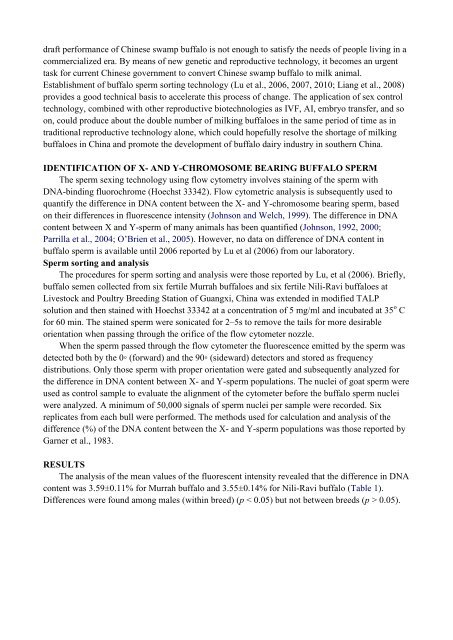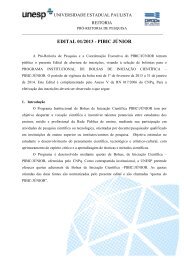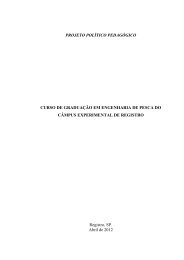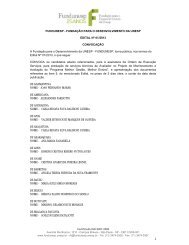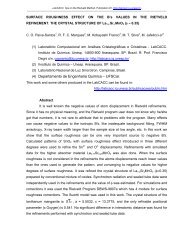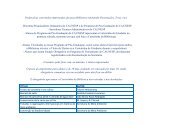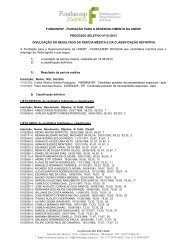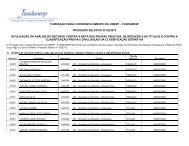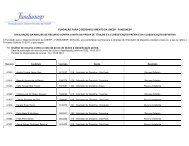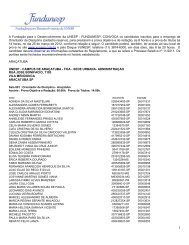Untitled - Faculdade de Medicina Veterinária e Zootecnia - Unesp
Untitled - Faculdade de Medicina Veterinária e Zootecnia - Unesp
Untitled - Faculdade de Medicina Veterinária e Zootecnia - Unesp
Create successful ePaper yourself
Turn your PDF publications into a flip-book with our unique Google optimized e-Paper software.
draft performance of Chinese swamp buffalo is not enough to satisfy the needs of people living in a<br />
commercialized era. By means of new genetic and reproductive technology, it becomes an urgent<br />
task for current Chinese government to convert Chinese swamp buffalo to milk animal.<br />
Establishment of buffalo sperm sorting technology (Lu et al., 2006, 2007, 2010; Liang et al., 2008)<br />
provi<strong>de</strong>s a good technical basis to accelerate this process of change. The application of sex control<br />
technology, combined with other reproductive biotechnologies as IVF, AI, embryo transfer, and so<br />
on, could produce about the double number of milking buffaloes in the same period of time as in<br />
traditional reproductive technology alone, which could hopefully resolve the shortage of milking<br />
buffaloes in China and promote the <strong>de</strong>velopment of buffalo dairy industry in southern China.<br />
IDENTIFICATION OF X- AND Y-CHROMOSOME BEARING BUFFALO SPERM<br />
The sperm sexing technology using flow cytometry involves staining of the sperm with<br />
DNA-binding fluorochrome (Hoechst 33342). Flow cytometric analysis is subsequently used to<br />
quantify the difference in DNA content between the X- and Y-chromosome bearing sperm, based<br />
on their differences in fluorescence intensity (Johnson and Welch, 1999). The difference in DNA<br />
content between X and Y-sperm of many animals has been quantified (Johnson, 1992, 2000;<br />
Parrilla et al., 2004; O’Brien et al., 2005). However, no data on difference of DNA content in<br />
buffalo sperm is available until 2006 reported by Lu et al (2006) from our laboratory.<br />
Sperm sorting and analysis<br />
The procedures for sperm sorting and analysis were those reported by Lu, et al (2006). Briefly,<br />
buffalo semen collected from six fertile Murrah buffaloes and six fertile Nili-Ravi buffaloes at<br />
Livestock and Poultry Breeding Station of Guangxi, China was exten<strong>de</strong>d in modified TALP<br />
solution and then stained with Hoechst 33342 at a concentration of 5 mg/ml and incubated at 35 o C<br />
for 60 min. The stained sperm were sonicated for 2–5s to remove the tails for more <strong>de</strong>sirable<br />
orientation when passing through the orifice of the flow cytometer nozzle.<br />
When the sperm passed through the flow cytometer the fluorescence emitted by the sperm was<br />
<strong>de</strong>tected both by the 0◦ (forward) and the 90◦ (si<strong>de</strong>ward) <strong>de</strong>tectors and stored as frequency<br />
distributions. Only those sperm with proper orientation were gated and subsequently analyzed for<br />
the difference in DNA content between X- and Y-sperm populations. The nuclei of goat sperm were<br />
used as control sample to evaluate the alignment of the cytometer before the buffalo sperm nuclei<br />
were analyzed. A minimum of 50,000 signals of sperm nuclei per sample were recor<strong>de</strong>d. Six<br />
replicates from each bull were performed. The methods used for calculation and analysis of the<br />
difference (%) of the DNA content between the X- and Y-sperm populations was those reported by<br />
Garner et al., 1983.<br />
RESULTS<br />
The analysis of the mean values of the fluorescent intensity revealed that the difference in DNA<br />
content was 3.59±0.11% for Murrah buffalo and 3.55±0.14% for Nili-Ravi buffalo (Table 1).<br />
Differences were found among males (within breed) (p < 0.05) but not between breeds (p > 0.05).


